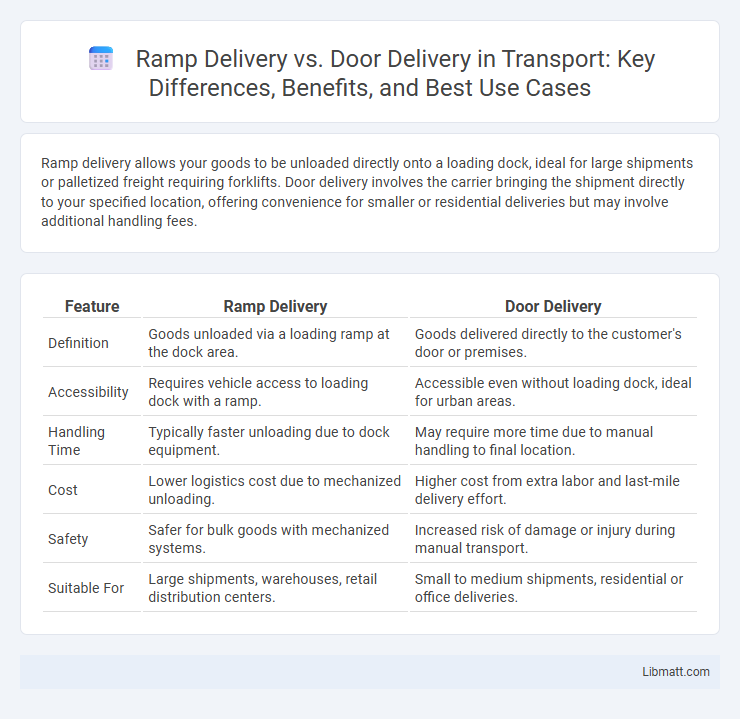Ramp delivery allows your goods to be unloaded directly onto a loading dock, ideal for large shipments or palletized freight requiring forklifts. Door delivery involves the carrier bringing the shipment directly to your specified location, offering convenience for smaller or residential deliveries but may involve additional handling fees.
Table of Comparison
| Feature | Ramp Delivery | Door Delivery |
|---|---|---|
| Definition | Goods unloaded via a loading ramp at the dock area. | Goods delivered directly to the customer's door or premises. |
| Accessibility | Requires vehicle access to loading dock with a ramp. | Accessible even without loading dock, ideal for urban areas. |
| Handling Time | Typically faster unloading due to dock equipment. | May require more time due to manual handling to final location. |
| Cost | Lower logistics cost due to mechanized unloading. | Higher cost from extra labor and last-mile delivery effort. |
| Safety | Safer for bulk goods with mechanized systems. | Increased risk of damage or injury during manual transport. |
| Suitable For | Large shipments, warehouses, retail distribution centers. | Small to medium shipments, residential or office deliveries. |
Understanding Ramp Delivery vs Door Delivery
Ramp delivery involves unloading goods at a loading dock using a dock leveler, enabling easier transfer to warehouse storage, while door delivery requires goods to be left outside the receiver's premises, often necessitating additional handling. Ramp delivery is preferred for shipments requiring forklift access and immediate indoor placement, ensuring protection from weather and damage. Door delivery suits locations without loading docks or when smaller deliveries are involved, despite potential risks like exposure and increased manual labor.
Key Differences Between Ramp and Door Delivery
Ramp delivery requires specialized equipment such as forklifts or pallet jacks to unload goods directly onto a loading dock ramp, enabling faster handling of large shipments. Door delivery involves transporting goods directly through the customer's entrance, often requiring manual unloading and suitable for smaller or fragile items. The choice impacts delivery speed, equipment needs, and accessibility based on the delivery location and shipment size.
Pros and Cons of Ramp Delivery
Ramp delivery offers efficient loading and unloading by allowing vehicles to back directly onto the ramp, reducing the need for additional handling equipment. It is ideal for heavy or bulky goods, minimizing physical strain and speeding up the delivery process, but it requires proper site infrastructure and can be limited by vehicle size and ramp durability. Potential drawbacks include safety risks from uneven surfaces and weather exposure, which can complicate operations and increase maintenance costs.
Advantages of Door Delivery Services
Door delivery services provide unmatched convenience by eliminating the need for customers to travel or arrange additional transportation. This method ensures faster and more efficient delivery directly to the recipient's specified location, reducing handling and potential damage. Enhanced customer satisfaction and streamlined logistics operations are key benefits driving the popularity of door delivery over ramp delivery options.
Cost Comparison: Ramp vs Door Delivery
Ramp delivery generally incurs higher costs due to the need for specialized equipment and additional labor to unload cargo at elevated dock levels, whereas door delivery typically involves standard curbside unloading with fewer logistical complexities. Shipping rates for door delivery are often lower because it requires less handling and quicker turnaround times, reducing overall freight expenses. Your choice between ramp and door delivery should consider not only the upfront costs but also potential delays and handling fees associated with ramp services.
Delivery Timeframes: Ramp vs Door Options
Ramp delivery typically offers faster unloading times due to direct access to loading docks, reducing handling and wait periods. Door-to-door delivery provides convenience by bringing goods directly to your specified location, though it may require more time due to additional transit and maneuvering. Your choice between ramp and door delivery impacts overall delivery timeframes based on site accessibility and cargo handling needs.
Safety and Security Considerations
Ramp delivery offers enhanced safety with reduced manual handling, lowering the risk of worker injuries by enabling direct loading and unloading at dock level. Door delivery requires careful coordination to secure goods during transit and protect against theft or damage due to exposure at entry points. Implementing proper protocols and equipment for both methods ensures optimal security and minimizes hazards during the delivery process.
Customer Experience and Convenience
Ramp delivery offers customers direct unloading access at the building entrance, minimizing wait times and reducing physical strain. Door delivery enhances convenience by bringing goods directly inside homes or offices, eliminating the need for customers to move heavy items themselves. Both methods improve overall satisfaction by tailoring delivery options to the customer's specific accessibility and handling preferences.
Choosing the Right Delivery Option for Your Needs
Ramp delivery offers the advantage of easy loading and unloading for heavy or bulky items, minimizing the need for additional equipment. Door delivery provides convenience by bringing shipments directly to your specified location, ideal for smaller or lighter goods. Assess the size, weight, and handling requirements of your cargo to select the most efficient and cost-effective delivery option.
Future Trends in Delivery Methods
Ramp delivery is expected to integrate more automation and robotics to enhance efficiency, while door delivery continues evolving with smart lock technology and real-time tracking to improve convenience and security. You will see an increased emphasis on sustainability, with electric vehicles and eco-friendly packaging becoming standard across both methods. Innovations in AI-driven route optimization will further reduce delivery times and costs for ramp and door deliveries alike.
ramp vs door delivery Infographic

 libmatt.com
libmatt.com